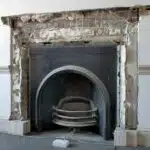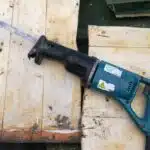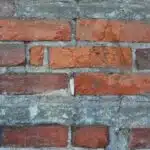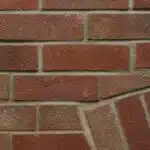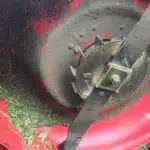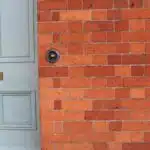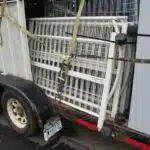As a brick mason or bricklayer, it is essential to know how to cut and remove bricks efficiently. This article aims to provide you with five methods that can make the process easier and more manageable. Whether you are working on a new construction project or renovating an existing structure, these techniques will come in handy.
The first method involves using a chisel and hammer to score the brick’s surface before breaking it along the scored line. The second method utilizes an angle grinder equipped with a diamond blade to cut through the brick’s surface quickly. The third technique includes using a circular saw with a masonry blade for precise cuts. The fourth approach involves drilling holes into the brick’s surface before using wedges and a sledgehammer to break it apart. Lastly, hydraulic splitters can be used to split bricks without generating any dust or debris. By learning these methods, you will be able to save time and effort while ensuring that your work is of high quality.
Understanding The Importance Of Efficient Brick Cutting And Removal
As a brick mason, I understand the importance of efficient brick cutting and removal. It is a critical task that requires careful planning and execution to ensure quality results. When done correctly, it can bring many benefits to both the homeowner and the contractor. One of the most significant benefits of using professional brick cutting services is that it saves time and money. Professional brick cutters have the necessary tools and equipment to complete the job quickly, safely, and efficiently.
However, safety precautions must always be taken when cutting and removing bricks. Brick dust can cause respiratory problems if inhaled, while small debris may cause eye injuries. Proper protective gear should be worn at all times during the process. Safety goggles, gloves, masks, and earplugs are essential items that should be used every time you work with bricks.
In summary, understanding the importance of efficient brick cutting and removal cannot be overstated. The benefits of using professional brick cutting services include saving time and money while ensuring high-quality results. However, safety must always come first when working with bricks to prevent accidents or injuries from occurring. With this in mind, let us now move onto method 1: chisel and hammer for cutting and removing bricks.
Method 1: Chisel And Hammer
As a brick mason or bricklayer, understanding the importance of efficient brick cutting and removal is critical for the success of any project. There are various methods available for cutting and removing bricks, but it is essential to choose the most suitable one based on the type of job at hand. In this section, we will discuss method 1: chisel and hammer.
When using the chisel and hammer method, there are several tips to keep in mind. Firstly, always wear personal protective equipment such as gloves, safety glasses, and a dust mask to avoid injuries from flying debris. Secondly, take your time when cutting through the brick to ensure that you do not go off-course or cut too deep. Lastly, make sure that you have a sturdy work surface and that you place the brick securely.
Safety precautions must be taken when using this method. Always strike with precision and control to avoid damaging the surrounding bricks or injuring yourself. Additionally, never hit your chisel with excessive force as this could cause it to break or slip, leading to injury.
Step 1: Scoring the brick’s surface is crucial before attempting to cut it with a chisel and hammer. This technique involves running your chisel along the line where you want to make your cut while tapping gently with a hammer until you create a shallow groove on all sides of the brick. This groove will help guide your cuts when using the chisel and hammer method later on in the process.
Step 1: Scoring The Brick’s Surface
Scoring the brick’s surface is a crucial step in cutting and removing bricks. There are various scoring techniques that you can utilize, depending on the type of brick and the tool that you have at hand. One of the most common methods is using a chisel and hammer to score the brick along the line where you want to cut it. Alternatively, you can use a circular saw with a masonry blade or an angle grinder equipped with a diamond blade.
Whichever technique you choose, safety should always be your top priority. Make sure that you wear protective gear such as safety glasses, work gloves, and earplugs to prevent accidents from flying debris and loud noise. Furthermore, ensure that your work area is free from any clutter or obstruction that could cause tripping or slipping.
Scoring the brick’s surface may seem like a simple task, but it requires precision and attention to detail. Take your time and make sure that you score the line accurately to avoid damaging adjacent bricks or creating unnecessary waste materials. Once you have scored the brick along the desired line, proceed to break it apart using appropriate tools according to its thickness and hardness.
Transitioning into Step 2: Breaking the Brick Along the Scored Line – now that you’ve successfully scored your brick along the desired line, it’s time to break it apart using specialized tools such as a brick hammer or bolster chisel.
Step 2: Breaking The Brick Along The Scored Line
As we begin breaking the brick along the scored line, it is important to remember that safety should always come first. Using safety equipment such as gloves and safety glasses can prevent serious injuries. Just like a brick wall needs a strong foundation, so too does our process of cutting and removing bricks require a strong emphasis on safety.
For beginners, it may be helpful to keep in mind some tips as you approach this step. Firstly, use a chisel and hammer to slowly break the brick along the scored line. Secondly, make sure the force used is consistent and not too hard or too soft. Thirdly, do not rush the process; take your time and work carefully to avoid damaging surrounding bricks.
To further enhance your approach towards breaking bricks along the scored line, here are four additional tips:
- Use a masonry saw with a diamond blade for precise cuts.
- Create shallow grooves on both sides of the scored line before breaking.
- Remove any debris from the area before starting.
- Always have a backup plan in case something goes wrong.
As we move on to discussing method 2: angle grinder with diamond blade, it is important to keep in mind that each method has its own unique set of challenges and requires careful attention to detail. By following these tips and prioritizing safety, you can successfully break bricks along the scored line without causing damage or injury.
Method 2: Angle Grinder With Diamond Blade
After breaking the brick along the scored line, the next method to cut and remove bricks is by using an angle grinder with a diamond blade. This technique is ideal for cutting through tough materials like concrete, stone, and bricks. However, choosing the right diamond blade is crucial to ensure a clean and precise cut.
Before using an angle grinder with a diamond blade, there are safety precautions that one should take into consideration. First of all, wear protective gear such as gloves, goggles, earplugs or earmuffs, and a dust mask. Secondly, secure the workpiece on a stable surface to avoid slips or falls while working. Lastly, make sure that the tool’s power cord is out of reach from you while in use.
To begin preparing the angle grinder for cutting brick with a diamond blade, first choose the correct attachment for your tool. Then securely attach it to your angle grinder. Once that is done, inspect the blade for any cracks or damages before installing it onto your tool. After installation is complete, check whether the blade rotates in its designated direction without wobbling or vibrating excessively. With these preparations in place – you can now move on to cutting and removing bricks using an angle grinder with a diamond blade.
Step 1: Preparing The Angle Grinder
When it comes to brick cutting, an angle grinder is a popular tool of choice for many masons. However, before beginning the process, it is essential to prepare the angle grinder properly. This involves selecting the right grinder and using safety precautions to prevent accidents.
Selecting the right grinder for the job is critical. It is recommended to use a 4-inch or 4.5-inch angle grinder with a diamond blade that can cut through bricks with ease. Additionally, consider purchasing a dust shroud and vacuum attachment to reduce dust particles in the air and protect your lungs.
Using safety precautions when preparing your angle grinder is paramount. Ensure that you wear personal protective equipment such as goggles, gloves, and a respirator mask to avoid inhaling harmful dust particles. Before beginning any work, inspect your tools thoroughly and ensure they are in good condition. Finally, double-check that your workspace is clear of any potential hazards that could cause accidents.
Now that you have selected the appropriate angle grinder and taken all necessary safety precautions, it’s time to move on to cutting through the brick.
Step 2: Cutting Through The Brick
One of the most effective ways to cut through a brick is by using a brick saw. This tool is specifically designed for cutting through bricks, and it makes the process much easier and efficient. When using a brick saw, it’s important to follow proper safety procedures, such as wearing eye protection and gloves.
Brick cutting techniques can vary depending on the type of cut you need to make. For instance, if you need to make a straight cut through the center of a brick, you’ll need to mark the spot where you want to cut with a pencil or chalk. Then, slowly lower the blade of the saw onto the marked spot while keeping your hands steady. Be sure not to force the blade through the brick too quickly, as this can cause it to crack or break.
Using a circular saw with a masonry blade is another popular method for cutting through bricks. This technique involves making several passes with the saw until you’ve cut all the way through the brick. It’s important to keep in mind that circular saws can be dangerous if not used properly, so always follow safety guidelines when working with this tool. In our next section, we’ll go over step-by-step instructions for using this method effectively and safely.
Method 3: Circular Saw With Masonry Blade
When it comes to cutting and removing bricks, one of the most effective methods involves using a circular saw with a masonry blade. This method is especially useful for making precise cuts that are needed for specific projects. However, it’s important to use safety precautions when working with power tools like circular saws.
One of the advantages of using a circular saw with a masonry blade is that it allows you to make straight cuts quickly and easily. Unlike other cutting methods, such as chiseling or using a hammer and bolster, the circular saw allows you to cut through bricks efficiently without creating excess dust or debris. Additionally, circular saws are often equipped with adjustable depth settings, which makes it easier to control the depth of each cut.
When using a circular saw with a masonry blade, it’s crucial that you take proper safety precautions. Always wear protective gear such as goggles, earplugs, and gloves when working with power tools. Before starting your project, ensure that the blade is properly aligned and tightened on the saw. Finally, make sure that the blade is sharp in order to avoid any unnecessary accidents or injuries.
Transition: Now that we’ve discussed some of the advantages of using a circular saw with a masonry blade and emphasized the importance of taking safety precautions while working with power tools like this one, let’s move on to step 1: setting up the circular saw for your brick-cutting project.
Step 1: Setting Up The Circular Saw
Method 3 of cutting and removing bricks involves the use of a circular saw with a masonry blade. Setting up the saw requires adjusting the blade depth to ensure precise cuts are made. Safety precautions must also be taken during setup to avoid accidents.
Adjusting blade depth is important when using a circular saw for brick cutting. The depth of the blade needs to be set to match the thickness of the brick being cut. Setting it too shallow will not produce clean cuts, while setting it too deep may cause damage to the saw or create safety hazards.
Safety should always be a top priority when working with power tools like circular saws. Before making any cuts, ensure that the saw is properly secured and stable. Always wear appropriate personal protective equipment like safety glasses and gloves. Keep bystanders at a safe distance from the work area, and never leave a running saw unattended.
- Three tips for circular saw safety during setup:
- Check that all guards are in place before starting.
- Use clamps or other secure methods to keep bricks in place.
- Always disconnect power before making adjustments or changing blades.
With the circular saw set up properly and safety measures in place, you can now move on to step two: making precise cuts. By following these steps carefully, you can effectively cut and remove bricks using this method with confidence and ease.
Step 2: Making Precise Cuts
When cutting brick, it is important to use a brick saw to ensure a precise and clean cut. Before cutting, all measurements and cut lines should be marked clearly and accurately to ensure the best possible results. When using a brick saw, the blade should be positioned so that the cut is made in the center of the brick, to minimize chipping and breakage. To help achieve a smooth and accurate cut, pressure should be applied evenly on the saw blade as it moves along the cut line.
Using A Brick Saw
To make precise cuts when working with bricks, brick saws are an essential tool for any brick mason or bricklayer. These saws are designed to cut through the toughest of materials, ensuring that bricks can be cut accurately and with ease. When using a brick saw, it is important to take safety precautions seriously and always wear protective gear such as gloves and eye protection.
Maintenance of the brick saw is also crucial to ensure that it operates smoothly and efficiently. Regular cleaning of the blade will prevent buildup of dust and debris, which can cause the blade to become dull over time. Additionally, keeping the water reservoir full during operation is important in preventing overheating of the blade and maintaining accuracy of cuts.
Using a brick saw can greatly improve the precision and efficiency of cutting bricks for any project. By taking proper safety precautions and performing regular maintenance on the tool, brick masons can ensure that their work is both accurate and safe. Remember to always prioritize safety when working with any power tools on site.
Measuring And Marking Cut Lines
Measuring and marking cut lines is a crucial step in making precise cuts when working with bricks. Brick masons or bricklayers should always have measuring techniques in place before cutting to ensure that the bricks are cut to the correct size and shape. Using a measuring tape or a ruler can help achieve accurate measurements of the bricks, which will prevent wastage of materials and save time.
It is also important to take safety precautions when measuring and marking cut lines. Bricklayers should always wear protective gear such as gloves and eye protection, especially when using tools like pencils or chalks for marking. When using a ruler or straightedge, it is important to keep fingers away from the blade and avoid applying excessive pressure on the tool.
Overall, incorporating proper measuring techniques and safety precautions into the process of making precise cuts will lead to better results for any bricklaying project. By taking the time to measure accurately and mark cut lines carefully, brick masons can ensure that their work is both safe and efficient. Remember to prioritize safety at all times when working with power tools on site.
Method 4: Drilling Holes And Using Wedges And Sledgehammer
Using masonry drills for cutting and removing bricks is an excellent method that requires a high level of expertise to carry out the process effectively. This approach is best suited for those who are familiar with drilling techniques and have advanced knowledge of brick removal. Masonry drills come in different sizes, which makes them versatile enough to drill holes in varying depths and diameters.
One significant advantage of using masonry drills is that it allows for a more controlled breakage process when removing broken bricks. With this method, the bricks can be dismantled gradually without causing damage to surrounding structures or materials. However, it is essential to exercise caution during the drilling process as excessive force can cause the drill bit to break or damage the brick.
Removing broken bricks using wedges and sledgehammer after drilling holes is an intricate process that must be done carefully by an experienced bricklayer. The wedge should be placed into the drilled hole, followed by hitting it gently with a sledgehammer until it creates a crack in the brick. Once this has been achieved, you can then use the sledgehammer to remove the broken pieces carefully. This method requires patience, precision, and attention to detail, but with practice, it can become second nature.
Transition: To begin using masonry drills on bricks, we’ll first need to understand how to drill holes through them effectively.
Step 1: Drilling Holes In The Brick
To begin the process of cutting and removing brick, the first step is to drill holes into the brick. This is a crucial step that requires precision and attention to detail in order to ensure that the brick is cut properly. One of the most important things to keep in mind during this step is safety. It’s critical that you wear appropriate protective gear such as goggles and gloves, as well as avoid drilling near any electrical wires.
There are several alternative techniques that can be used in addition to drilling holes in the brick. For instance, some people may choose to use a hammer and chisel instead. However, it’s important to note that this method requires more physical effort than drilling holes and can result in less precise cuts. Regardless of which method you choose, always make sure to take necessary safety precautions.
When drilling holes into the brick, it’s essential to use a masonry bit specifically designed for this purpose. These bits are made from high-quality materials and are able to withstand the pressure required for drilling through dense materials like bricks. Additionally, it’s important to keep the drill bit lubricated with water or oil in order to prevent overheating and prolong its lifespan.
Moving on from step 1, inserting wedges and using a sledgehammer is another effective technique for cutting and removing brick. By following these steps carefully and taking all necessary safety precautions, you’ll be able to successfully cut through bricks with ease.
Step 2: Inserting Wedges And Using The Sledgehammer
- Wedges are inserted into the mortar joints of a brick wall in order to create a gap to create separation of the bricks.
- The sledgehammer is then used to apply force to the wedges in order to separate the bricks from the wall.
- Placement of the wedges is critical to ensure that the force is directed to the appropriate area and applied in a safe manner.
- Safety is paramount when using a sledgehammer, as the force applied to the wedges must be controlled in order to prevent damage to the bricks or surrounding structures.
Wedges
When it comes to cutting and removing bricks, using wedges is a tried and tested method that has been used by brick masons for generations. Wedges are simple tools consisting of a tapered metal shape that is driven into the brick with a sledgehammer. Using wedges requires skill and experience, as it can be difficult to control the direction and force of the blow. However, with some tips and tricks, this method can be mastered by any experienced bricklayer.
One important tip when using wedges is to make sure they are properly aligned before striking them with the sledgehammer. This means ensuring that the wedge is pointed in the right direction, and positioned at the correct angle relative to the surface of the brick. Another key factor is to use a sledgehammer that is appropriate for the job at hand. A heavier hammer may be required for thicker or harder bricks, while a lighter hammer can be used for smaller or softer ones.
While wedges are an effective tool for cutting and removing bricks, there are also alternative tools available that may be more suitable depending on the task at hand. For example, chisels and hammers can be used to chip away at individual bricks or sections of brickwork, while power tools such as grinders or saws can be used for larger-scale projects. Ultimately, choosing the right tool for each job requires careful consideration of factors such as precision, speed, safety, and cost-effectiveness.
Sledgehammer
When it comes to bricklaying, using wedges and a sledgehammer is a common method for cutting and removing bricks. The first step of this process is inserting the wedges into the brick, followed by striking them with a sledgehammer. While wedges are effective at splitting bricks, using a sledgehammer requires skill and experience to control the direction and force of the blow.
It’s important to take safety precautions when using a sledgehammer. First, ensure that the work area is clear of debris and other hazards that may cause tripping or slipping. It’s also crucial to wear appropriate personal protective equipment such as gloves, safety goggles, and ear protection. Additionally, choose an appropriate weight for the sledgehammer based on the thickness and hardness of the brick being worked on.
While wedges and a sledgehammer are commonly used in bricklaying, there are alternative tools available depending on the specific task at hand. Chisels and hammers can be used for chipping away at individual bricks or sections of brickwork while power tools such as grinders or saws can be used for larger-scale projects. It’s important to carefully consider factors such as precision, speed, safety, and cost-effectiveness when choosing which tool to use for each project.
Method 5: Hydraulic Splitters
After inserting wedges and using the sledgehammer, you may be feeling quite pleased with yourself. However, there is another method that can make your job easier. Enter hydraulic splitters – the latest and greatest tool in brick cutting technology. The irony here is that while this method is undoubtedly more advanced than the traditional sledgehammer, it still relies on a forceful impact to split the brick.
Hydraulic splitters have several advantages over other methods of brick removal. Firstly, they are quicker and more efficient than manual methods like chiseling or sledgehammering. Secondly, they produce less noise pollution and are therefore a more considerate option if you’re working in a built-up area. Finally, hydraulic splitters are less physically demanding than using a sledgehammer, which can be a boon if you’re working on a large project.
However, as with any tool or technique, there are limitations to using hydraulic splitters for cutting and removing bricks. One of the main drawbacks is that they require a power source, which means that you need access to electricity or fuel to operate them. They are also relatively expensive compared to traditional tools like chisels and hammers. Additionally, hydraulic splitters can only be used on certain types of bricks – particularly those with regular dimensions and composition.
To use a hydraulic splitter for cutting and removing bricks, you must first set up the machine according to its instructions. Once done properly, you can begin splitting the brick by slowly applying pressure until it cracks along its natural fault lines. This process may take some practice to perfect but once mastered will significantly speed up your work process.
Step 1: Setting Up The Hydraulic Splitter And Splitting The Brick
To begin the brick cutting process, the first step is to set up the hydraulic splitter. This machine is a powerful tool that can split bricks cleanly and efficiently. Safety measures must be taken when using this tool to avoid injuries or accidents. To ensure safety, operators must always wear protective gear such as gloves, goggles, and sturdy shoes. The hydraulic splitter must also be placed on a stable surface before use.
After setting up the hydraulic splitter, it’s time to start splitting the brick. However, issues with the machine may arise during operation. Common problems include leaks in the hydraulic system or failure of the machine to generate enough force to split the brick cleanly. Troubleshooting these issues requires knowledge of how the machine operates and its components. It’s important for operators to be familiar with how each part of the hydraulic splitter works in order to diagnose and repair any problems.
In summary, setting up a hydraulic splitter is an essential step in brick cutting. Operators must prioritize safety by wearing protective gear and ensuring that the machine is placed on a stable surface before use. Troubleshooting any issues that arise during operation requires knowledge of how each component of the machine works together. By following these guidelines, operators can safely and efficiently cut bricks using a hydraulic splitter.
Conclusion
Efficient brick cutting and removal is a crucial task for any brick mason or bricklayer. The use of proper tools and techniques can save time, effort, and minimize wastage. From using a chisel and hammer to hydraulic splitters, there are various methods that can be used depending on the thickness of the brick and the desired outcome.
While some methods may require more skill than others, it is important to choose the method that suits your level of expertise. Whether you are breaking bricks for construction or demolition purposes, it is essential to ensure safety measures are in place. In conclusion, mastering the art of cutting and removing bricks is critical for any brick mason or bricklayer. It requires patience, skill, and experience to achieve the desired results. By utilizing the right tools and techniques, this task can be completed efficiently with minimal wastage.
Image Credits
- “Brick removal crew” by Plant Chicago (featured)







